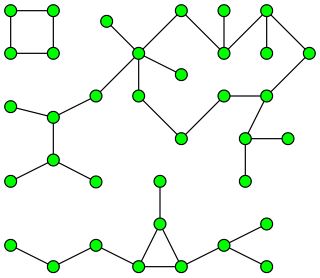Related Research Articles

Vladimir Batagelj is a Slovenian mathematician and an emeritus professor of mathematics at the University of Ljubljana. He is known for his work in discrete mathematics and combinatorial optimization, particularly analysis of social networks and other large networks (blockmodeling).

In graph theory, a component of an undirected graph is a connected subgraph that is not part of any larger connected subgraph. The components of any graph partition its vertices into disjoint sets, and are the induced subgraphs of those sets. A graph that is itself connected has exactly one component, consisting of the whole graph. Components are sometimes called connected components.

Mathematical sociology or the sociology of mathematics is an interdisciplinary field of research concerned both with the use of mathematics within sociological research as well as research into the relationships that exist between maths and society.
Social network analysis (SNA) software is software which facilitates quantitative or qualitative analysis of social networks, by describing features of a network either through numerical or visual representation.
Anuška Ferligoj is a Slovenian mathematician, born August 19, 1947, in Ljubljana, Slovenia, whose specialty is statistics and network analysis. Her specific interests include multivariate analysis, cluster analysis, social network analysis, methodological research of public opinion, analysis of scientific networks. She is Fellow of the European Academy of Sociology.

Main path analysis is a mathematical tool, first proposed by Hummon and Doreian in 1989, to identify the major paths in a citation network, which is one form of a directed acyclic graph (DAG). It has since become an effective technique for mapping technological trajectories, exploring scientific knowledge flows, and conducting literature reviews.

Blockmodeling is a set or a coherent framework, that is used for analyzing social structure and also for setting procedure(s) for partitioning (clustering) social network's units, based on specific patterns, which form a distinctive structure through interconnectivity. It is primarily used in statistics, machine learning and network science.
Aleš Žiberna is a Slovene statistician, whose specialty is network analysis. His specific research interests include blockmodeling, multivariate analysis and computer intensive methods.
Patrick Doreian is an American mathematician and social scientist, whose specialty is network analysis. His specific research interests include blockmodeling, social structure and network processes.
Andrej Mrvar is a Slovenian computer scientist and a professor at the University of Ljubljana. He is known for his work in network analysis, graph drawing, decision making, virtual reality, electronic timing and data processing of sports competitions.
Deterministic blockmodeling is an approach in blockmodeling that does not assume a probabilistic model, and instead relies on the exact or approximate algorithms, which are used to find blockmodel(s). This approach typically minimizes some inconsistency that can occur with the ideal block structure. Such analysis is focused on clustering (grouping) of the network that is obtained with minimizing an objective function, which measures discrepancy from the ideal block structure.
Generalized blockmodeling of valued networks is an approach of the generalized blockmodeling, dealing with valued networks.
In mathematics applied to analysis of social structures, homogeneity blockmodeling is an approach in blockmodeling, which is best suited for a preliminary or main approach to valued networks, when a prior knowledge about these networks is not available. This is due to the fact, that homogeneity blockmodeling emphasizes the similarity of link (tie) strengths within the blocks over the pattern of links. In this approach, tie (link) values are assumed to be equal (homogenous) within blocks.
Blockmodeling linked networks is an approach in blockmodeling in analysing the linked networks. Such approach is based on the generalized multilevel blockmodeling approach. The main objective of this approach is to achieve clustering of the nodes from all involved sets, while at the same time using all available information. At the same time, all one-mode and two-node networks, that are connected, are blockmodeled, which results in obtaining only one clustering, using nodes from each sets. Each cluster ideally contains only nodes from one set, which also allows the modeling of the links among clusters from different sets. This approach was introduced by Aleš Žiberna in 2014.
Linked network in statistics is a network, which is composed of one-node networks, where the nodes from different one-node networks are connected through two-node networks. This means, that "linked networks are collections of networks defined on different sets of nodes", where all sets of nodes must be connected to each other.
Exploratory blockmodeling is an (inductive) approach in blockmodeling regarding the specification of an ideal blockmodel. This approach, also known as hypotheses-generating, is the simplest approach, as it "merely involves the definition of the block types permitted as well as of the number of clusters." With this approach, researcher usually defines the best possible blockmodel, which then represent the base for the analysis of the whole network.
Confirmatory blockmodeling is a deductive approach in blockmodeling, where a blockmodel is prespecify before the analysis, and then the analysis is fit to this model. When only a part of analysis is prespecify, it is called partially confirmatory blockmodeling.
Implicit blockmodeling is an approach in blockmodeling, similar to a valued and homogeneity blockmodeling, where initially an additional normalization is used and then while specifying the parameter of the relevant link is replaced by the block maximum.
Generalized blockmodeling of binary networks is an approach of generalized blockmodeling, analysing the binary network(s).
References
- 1 2 3 4 Doreian, Patrick (2006). "Some Open Problem Sets for Generalized Blockmodeling". In Batagelj, Vladimir (ed.). Data Science and Classification. Springer. pp. 119–130. ISBN 978-3-540-34415-5.
- ↑ Miha Matjašič, Marjan Cugmas and Aleš Žiberna, blockmodeling: An R package for generalized blockmodeling, Metodološki zvezki, 17(2), 2020, 49–66.
- 1 2 Žiberna, Aleš (2009). "Evaluation of Direct and Indirect Blockmodeling of Regular Equivalence in Valued Networks by Simulations". Metodološki zvezki. 6 (2): 99–134.
- ↑ Žnidaršič, Anja; Doreian, Patrick; Ferligoj, Anuška (2012). "Absent Ties in Social Networks, their Treatments, and Blockmodeling Outcomes". Metodološki zvezki. 9 (2): 119–138.
- ↑ Doreian, Patrick; Batagelj, Vladimir; Ferligoj, Anuška (2004). Generalized Blockmodeling (Structural Analysis in the Social Sciences). Cambridge University Press. ISBN 0-521-84085-6.
- ↑ Žiberna, Aleš (2013). "Generalized blockmodeling of sparse networks". Metodološki zvezki. 10 (2): 99–119.
- ↑ "The Section on Mathematical Sociology's Harrison White Outstanding Book Award". American Sociological Association. Retrieved September 26, 2019.